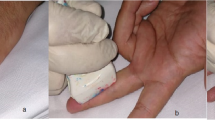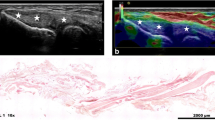Abstract
This paper examines the accuracy of ultrasound (US) in identifying closed flexor tendon ruptures and ruptures following recent flexor tendon repair. Between January 2001 and December 2006, 80 patients were investigated. Rates of accuracy between clinical examination and US findings were compared using the Wilcoxon signed ranks test. The chi square test was used to compare differences in sonographic accuracy according to the nature and zone of injury as well as time elapsed between injury and subsequent US. The accuracy of US was found to be significantly higher than clinical examination alone (95% vs. 79%, Z = 2.00, p = 0.03). Time between injury and US was the only variable to significantly affect diagnostic accuracy. US findings were 100% accurate when imaging was undertaken between 1 and 7 days following injury, 88% accurate when undertaken on the same day as injury and 85.7% accurate when performed after 1 week (X 2 = 6.4, p = 0.04). This retrospective study supports the notion that US can have a valuable role in the management of suspected closed flexor tendon ruptures and ruptures of recent flexor tendon repairs.


Similar content being viewed by others
References
Ogun TC, Ozdemir HM, Senaran H (2006) Closed traumatic avulsion of both flexor tendons in the ring finger. J Trauma 60(4):904–905
Kankaya Y, Oruc M, Uysal A, Kocer U (2006) Multiple closed flexor tendon avulsions from their insertions by a high-energy explosion. J Hand Surg [Br] 31(6):663–664
Kageyama Y, Sano M, Ishihara C et al (2006) Flexor tendon ruptures in both small fingers of a patient with rheumatoid arthritis. J Clin Rheumatol 12(2):103–104
Wang PT, Bonavita JA, DeLone FX Jr et al (1999) Ultrasonic assistance in the diagnosis of hand flexor tendon injuries. Ann Plast Surg 42(4):403–407
Jeyapalan K, Bisson MA, Dias JJ et al (2008) The role of ultrasound in the management of flexor tendon injuries. J Hand Surg Eur 33(4):430–434
Lee DH, Robbin ML, Galliott R, Graveman VA (2000) Ultrasound evaluation of flexor tendon lacerations. J Hand Surg [Am] 25(2):236–241
Knottnerus JA, Weel C, Muris JW (2002) Evaluation of diagnostic procedures. Br Med J 324:477–480
Swen WA, Jacobs JW, Hubach PC, Klasens JH, Algra PR, Bijlsma JW (2000) Comparison of sonography and magnetic resonance imaging for the diagnosis of partial tears of finger extensor tendons in rheumatoid arthritis. Rheumatology 39(1):55–62
Hollenberg GM, Adams MJ, Weinberg EP (2000) Sonographic appearance of nonoperatively treated Achilles tendon ruptures. Skeletal Radiol 29(5):259–264
Author information
Authors and Affiliations
Corresponding author
Rights and permissions
About this article
Cite this article
Gilleard, O., Silver, D., Ahmad, Z. et al. The accuracy of ultrasound in evaluating closed flexor tendon ruptures. Eur J Plast Surg 33, 71–74 (2010). https://doi.org/10.1007/s00238-009-0378-8
Received:
Accepted:
Published:
Issue Date:
DOI: https://doi.org/10.1007/s00238-009-0378-8




